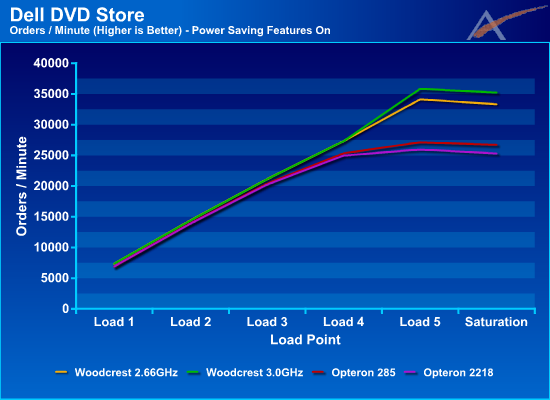AMD Socket-F Opteron vs. Intel Woodcrest
by Jason Clark & Ross Whitehead on December 18, 2006 12:05 AM EST- Posted in
- IT Computing
Dell DVD Store (Orders per minute)

Without any power saving features turned on, all four systems perform about the same for the first three Load Points. After the third Load Point the Woodcrest systems start to pull ahead and finish with a 23% lead at the fifth Load Point. It is interesting to note that the performance of the Opteron systems is almost identical. So what did Socket-F bring then, power saving? Also note, the performance of the Woodcrest systems is also very similar until after the fourth Load Point.

With all power saving features turned on, the performance is not all that different... which is a good thing! One small difference is that the 285 is now slightly faster than the 2218 beyond the fifth Load Point. The question is, is the 285 using more power to obtain slight faster performance?

Without any power saving features turned on, all four systems perform about the same for the first three Load Points. After the third Load Point the Woodcrest systems start to pull ahead and finish with a 23% lead at the fifth Load Point. It is interesting to note that the performance of the Opteron systems is almost identical. So what did Socket-F bring then, power saving? Also note, the performance of the Woodcrest systems is also very similar until after the fourth Load Point.

With all power saving features turned on, the performance is not all that different... which is a good thing! One small difference is that the 285 is now slightly faster than the 2218 beyond the fifth Load Point. The question is, is the 285 using more power to obtain slight faster performance?










38 Comments
View All Comments
yyrkoon - Monday, December 18, 2006 - link
After reading about FB-DIMMS, and the direct comparison to DDR2, I can not help but wonder, IF it were possible to use these Xeons with standard off the shelf DDR2, how well the Xeons would compare. Maybe this correlates with the quoted text above from your article, I do not know, as I don't know a lot about server grade equipment. Well, at least not "cutting edge" server equipment.
JarredWalton - Monday, December 18, 2006 - link
FB-DIMMs definitely use more power, and there's technically nothing to prevent someone from making a dual socket Xeon board that uses DDR2 or even DDR (or DDR3, etc.) instead of FB-DIMMs. However, for now Intel has decided that FB-DIMM DDR2 is the way they're going for workstation/server platforms, so all we can do is wonder "what if...?"Furen - Monday, December 18, 2006 - link
Huh? As I understand it there IS a difference. The FB memory controller is different and the pin configuration is significantly different, as half the pins connect to the memory controller, the other half connect to the next DIMM on the same channel. Then there's also the fact that having quad-channel DDR2 would require an insane amount of traces while quad-channel FB requires roughly the same amount of traces.yyrkoon - Tuesday, December 19, 2006 - link
Speed / power difference, silly . . .mino - Monday, December 18, 2006 - link
What has the memory controller to do with the possibility of sticking 2 Woodcrests on DDR2 chipset ???The only thing to play is the FSB compatibility.
BTW, NVIDIA is stepping in so such a platform is pretty much possible in 2007. SLI Quadro anyone...
joex444 - Monday, December 18, 2006 - link
Interesting, not what you mom said last night. Oh, who got pwned?glennpratt - Monday, December 18, 2006 - link
He didn't say there isn't a difference, did he?ltcommanderdata - Monday, December 18, 2006 - link
I guess AMD is encouraging many sites to do this heads on comparison since Tech Report has one too with similar systems. They swapped in a pair of 2.67GHz X5355 Clovertons too which was interesting. It's good that you put in a pair of E5150s though since that's probably more comparable to the 2nd from the top 2.6GHz 2218s that AMD provided.What I would love to see is data points for the top of the line 2.8GHz 2220SE, to see if the power numbers are actually that much worse, and a 2.4GHz 2216HE to see if the power numbers are that much better. I'd also be interested in seeing a pair of 2.33GHz 5148 Woodcrests reviewed since I haven't seen anyone look to see how much better the LV chips are compared to regular 65W and 80W Woodcrests.
It may not be that fair a comparison, but inclusion of the 2.67GHz X5355 Cloverton like Tech Report did would also be informative. Although, data for the 2.33Ghz E5345 Cloverton is probably more important since it still offers a 1333MHz FSB while keeping a 80W TDP of the lower parts, theoretically putting it in the sweet spot for performance/watt.
It should probably be pointed out too that Tech Report also tried a 4x2GB configuration for the FB-DIMMs and they found they saved 22W or something, compared to a 8x1GB configuration. That's something to note for system configurators and leaves more room for future expansion too.